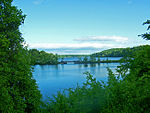Lake Gilead
Lake Gilead is a 116-acre (0.47 km2) controlled lake located in Carmel Hamlet in Putnam County, New York. Originally known as Dean's Pond, it is 0.8 miles long, has a mean depth of 43 feet (13 m), and a maximum depth of approximately 120 feet (37 m). The lake is located within the lower Hudson River basin in the Croton River watershed. Lake Gilead is part of the Croton Watershed of the New York City water supply system. A dam and spillway are located on its southern end, with a 500' shore-to-shore set-back restricting boaters from the area.Recreational use of the controlled lakes falls under DEP regulations. Fishing and self-powered boating are allowed with a valid DEP permit and New York State Department of Environmental Conservation-issued fishing license. Swimming is prohibited. Ice fishing is allowed on Lake Gilead during the winter. Fish species present include (but are not limited to) largemouth bass, rainbow, lake and brown trout, chain pickerel, yellow perch, and panfish. In the 1990s a local fisherman illegally introduced northern pike, though they are rarely caught.
Excerpt from the Wikipedia article Lake Gilead (License: CC BY-SA 3.0, Authors).Lake Gilead
Rock Road North,
Geographical coordinates (GPS) Address Nearby Places Show on map
Geographical coordinates (GPS)
| Latitude | Longitude |
|---|---|
| N 41.397777777778 ° | E -73.675555555556 ° |
Address
Rock Road North 47
10512
New York, United States
Open on Google Maps










